MGAs go to the Emerald Isle Part 2: Ulster to Sligo to Essex

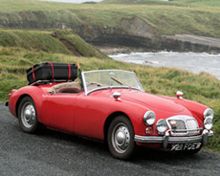 Following our MGCC Ulster tour in Northern Ireland, our six MGAs and one MG6 had an important location to visit in the area before we set off for Sligo in the Republic of Ireland, the other part of the Emerald Isle.
Following our MGCC Ulster tour in Northern Ireland, our six MGAs and one MG6 had an important location to visit in the area before we set off for Sligo in the Republic of Ireland, the other part of the Emerald Isle.
Ulsterman Mervyn Gillespie, one of our group, remembered his uncle’s Belfast garage being used for scrutineering of the race cars competing in the 1955 Tourist Trophy race, and as the EX182 Le Mans MGAs had competed in this event at the Dundrod circuit, Mervyn was keen to take us there. It is still used for the motorcycle Ulster Grand Prix, which we managed to watch on local TV a few nights before. We were amazed to see the bikes exceeding 180 mph on the narrow winding country roads that make up the circuit, without a safety barrier or run-off area to be seen. Almost as scary, we learned that back in 1955 the leading Jaguar and Mercedes were exceeding 140 mph in places but the fatalities in that year’s race prompted the subsequent ending of car events on the circuit.
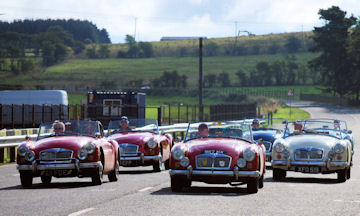 The sun came out as we arrived at the Dundrod start/finish straight and lined up our MGAs to wait for a break in the traffic. Why? Well, Mervyn wanted to us to attempt a grid line-up and mock race start, which would require us to use both sides of the two-way road. Fortunately, it being a quiet Sunday morning, we soon got our opportunity and were able to fill the grid with our MGAs before setting off to lap the circuit, albeit reverting to single-file at the first sign of oncoming traffic. Appropriately, Mervyn led the way. All great fun, and photos were taken to prove it!
The sun came out as we arrived at the Dundrod start/finish straight and lined up our MGAs to wait for a break in the traffic. Why? Well, Mervyn wanted to us to attempt a grid line-up and mock race start, which would require us to use both sides of the two-way road. Fortunately, it being a quiet Sunday morning, we soon got our opportunity and were able to fill the grid with our MGAs before setting off to lap the circuit, albeit reverting to single-file at the first sign of oncoming traffic. Appropriately, Mervyn led the way. All great fun, and photos were taken to prove it!
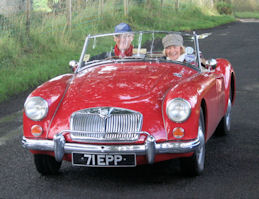 We then commenced Mike Maze’s tour, with his MGA leading the way to our next stop at Enniskillen. This is a pretty town with a long and varied main street, tragically made famous by an Irish Republican Army (IRA) bomb that killed eleven people at a Remembrance Day ceremony in 1987. More recently, the town hosted the 2013 G8 summit where Russian President Putin famously disagreed with President Obama on the subject of Syria. Our route then took us due west, pausing for lunch at Florence Court, original home of the Earls of Enniskillen before crossing into the Republic of Ireland. Never one to miss a viewpoint, we diverted to view the pretty Glencar Lake and waterfall shortly before arriving at the coastal town of Sligo. A forty-year ambition achieved at last.
We then commenced Mike Maze’s tour, with his MGA leading the way to our next stop at Enniskillen. This is a pretty town with a long and varied main street, tragically made famous by an Irish Republican Army (IRA) bomb that killed eleven people at a Remembrance Day ceremony in 1987. More recently, the town hosted the 2013 G8 summit where Russian President Putin famously disagreed with President Obama on the subject of Syria. Our route then took us due west, pausing for lunch at Florence Court, original home of the Earls of Enniskillen before crossing into the Republic of Ireland. Never one to miss a viewpoint, we diverted to view the pretty Glencar Lake and waterfall shortly before arriving at the coastal town of Sligo. A forty-year ambition achieved at last.
Mary Maze had specified a full day of activities in her family’s home county of Sligo, combining history, culture, walks ranging from the leisurely to the exhausting and ending up with an evening in a traditional Irish pub.
We started with a breath of sea air whilst stretching our legs with a walk to Rosses Point. There was a fine statue here of a woman with outstretched arms, called ‘Waiting on Shore,’ symbolizing women whose menfolk have been lost at sea. I felt it could equally well represent mothers whose sons had emigrated to America, perhaps never to return. Another impressive sculpture on our Sligo itinerary included one of Constance Gore Booth, the Irish suffragette who, despite being jailed for republican sympathies, became the first female MP to be elected to the British parliament. Our educational tour then continued with a coffee-stop near the grave of Irish poet Y. B. Yeates in Drumcliff churchyard, clearly a well-visited site if the number of tour buses was anything to go by, and then on around Lough Gill to the picturesque ruins of Creevelea Abbey. It was largely destroyed by Oliver Cromwell in 1650 at the time of the English Revolution.
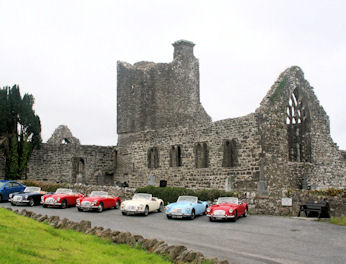 After a welcome seaside lunch at the beachside town of Strandhill, I was surprised to see my name in the Roadbook instructions for the afternoon. It stated that I had asked if we could undertake the half-mile climb up the 1000 ft landmark Knocknarea that is capped by the Neolithic passage tomb known as Queen Maeve’s Cairn. I confess I had failed to notice the altitude when I spotted the site on a map of the area but, having been name-checked, I just had to climb it. Most of us did so and the views from the top were well worth the effort. Here we had the only instance in Ireland of locals not respecting our MGAs as on our return to the parking lot some kids were opening the tonneau cover on one of the cars, obviously looking for items to steal. Fortunately, seeing us, they quickly left and nothing was lost.
After a welcome seaside lunch at the beachside town of Strandhill, I was surprised to see my name in the Roadbook instructions for the afternoon. It stated that I had asked if we could undertake the half-mile climb up the 1000 ft landmark Knocknarea that is capped by the Neolithic passage tomb known as Queen Maeve’s Cairn. I confess I had failed to notice the altitude when I spotted the site on a map of the area but, having been name-checked, I just had to climb it. Most of us did so and the views from the top were well worth the effort. Here we had the only instance in Ireland of locals not respecting our MGAs as on our return to the parking lot some kids were opening the tonneau cover on one of the cars, obviously looking for items to steal. Fortunately, seeing us, they quickly left and nothing was lost.
We then had yet another scenic drive back to Sligo town where Mike and Mary had kindly arranged transportation for an evening’s traditional Irish musical entertainment at a pub. Here, quite a bit of Irish Guinness was consumed and Mervyn couldn’t resist demonstrating his dancing prowess to locals and tourists alike. He afterwards insisted that he was drunk on the atmosphere, not the Guinness!
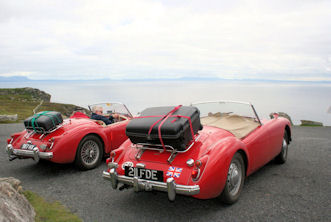 The following day we changed counties from Sligo to Donegal and, such is the meandering border of the Irish Republic, found ourselves a few yards back in Northern Ireland for a tour of the famous Belleek Pottery. Here we witnessed women crafting intricate ceramic items ranging from kitchenware to jewelry prior to their glazing and firing to produce the finished items that are exported all over the world. Yet another excellent lunch was enjoyed in the town of Donegal where some shopping was also undertaken and then we headed to the North Atlantic coast.
The following day we changed counties from Sligo to Donegal and, such is the meandering border of the Irish Republic, found ourselves a few yards back in Northern Ireland for a tour of the famous Belleek Pottery. Here we witnessed women crafting intricate ceramic items ranging from kitchenware to jewelry prior to their glazing and firing to produce the finished items that are exported all over the world. Yet another excellent lunch was enjoyed in the town of Donegal where some shopping was also undertaken and then we headed to the North Atlantic coast.
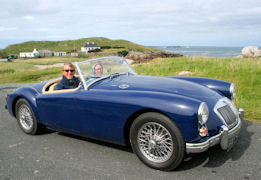 Our Roadbook warned us that this was Gaelic speaking Ireland and the roadsigns would not include English place names. However, having driven in countries not even using our alphabet, we were not at all fazed by this prospect and enjoyed the drive to view Slieve League, at c.1000 ft the second highest sea-cliffs in Ireland. I was conscious that the coast of Ireland had some absolutely stunning beaches with white to golden sands and clear blue water, yet they were little used. It was on this subject that the most memorable ‘quote’ of the tour for me occurred. At nearby Malin Bay yet another family wanted to take photos of themselves by our MGA and I commented that the beach would be lovely if only the sea was warmer and the Dad replied “Oh, it’s just fine…up to the ankles!” The day ended at a welcoming hotel in Glenties where the innkeeper had no less than seven lovely daughters and our fellow MGA-ers did their best to match my son Tom with the pretty young waitress.
Our Roadbook warned us that this was Gaelic speaking Ireland and the roadsigns would not include English place names. However, having driven in countries not even using our alphabet, we were not at all fazed by this prospect and enjoyed the drive to view Slieve League, at c.1000 ft the second highest sea-cliffs in Ireland. I was conscious that the coast of Ireland had some absolutely stunning beaches with white to golden sands and clear blue water, yet they were little used. It was on this subject that the most memorable ‘quote’ of the tour for me occurred. At nearby Malin Bay yet another family wanted to take photos of themselves by our MGA and I commented that the beach would be lovely if only the sea was warmer and the Dad replied “Oh, it’s just fine…up to the ankles!” The day ended at a welcoming hotel in Glenties where the innkeeper had no less than seven lovely daughters and our fellow MGA-ers did their best to match my son Tom with the pretty young waitress.
We stayed inland the following morning, to take in the picturesque Glenveagh National Park, which has a 19th century castellated mansion (mock castle) and early swimming pool beside a beautiful lake. Its last private owner was American art enthusiast Henry P. Mc-Ilhenny of Philadelphia who kept part of his collection there where he also entertained the likes of Charlie Chaplin, Clark Gable, and Greta Garbo. Unfortunately, we did not see any of the golden eagles recently reintroduced to the area. Our afternoon drive took us along Donegal’s famous Atlantic Drive around the Rosguill Peninsula and then across to the Fanad Peninsula by way of the new Harry Blaney ‘bridge to nowhere,’ so nicknamed due to its justification allegedly being ‘pork barrel’ politics rather than traffic needs. We then drove to the tip of Fanad Head, where the sun came out for us to stretch our legs and photograph the picturesque lighthouse there before heading to the night’s hotel.
Our last day of the tour took us back to Northern Ireland for a visit to the Ulster American Folk Park. Founded by descendants of the U.S. Mellon banking family on Mellon ancestral farmland, it combines a museum explaining the significance of emigration of Ulster people to America in the 18th and 19th centuries with an outdoor area of mostly original reconstructed period properties of the time, from both sides of the Atlantic.
Notable exhibits include the Mellon family homestead still standing on its original site, a reconstructed Ulster street with period shop fronts, a reproduction dock and emigrant sailing ship interior, an American port scene with a replica of the first Mellon Bank, a log cabin, and a replica of the first Mellon house in Pennsylvania. As a schoolboy fan of western films, I was also fascinated by the genuine Conestoga ‘prairie schooner’ in the museum.
And so our visit to the Emerald Isle came to an end and the following morning the six MGA crews departed in different directions, two back to Dublin for a ferry to Liverpool and Tom and I with three other crews crossing the Irish Sea to Scotland. We drove as far as England that same day and finally arrived home the following afternoon.
Total mileage for our MGA: 2109 miles.
Total problems for six MGAs during two weeks touring; some mis-firing on three cars, some fuel seepage on two cars, a worn wiper blade on two cars, and my untested new soft-top.
Total number of tow-trucks required: None
Photos by Roger Martin and Tom Martin

